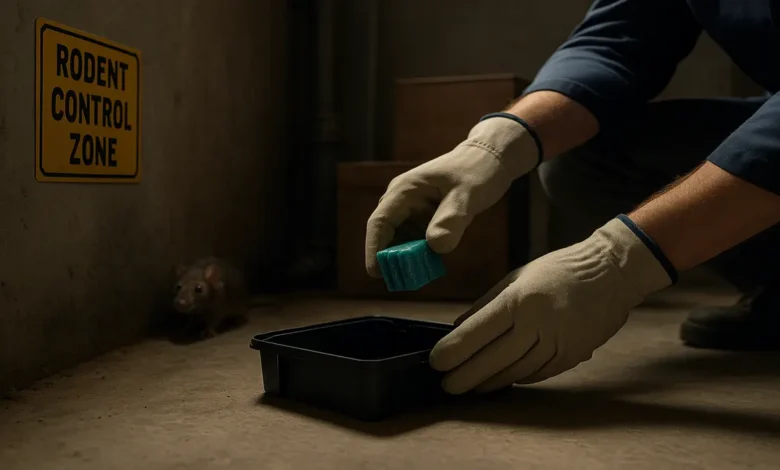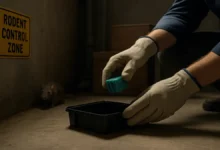Rat Poison Rodenticide: Safe, Effective, and Responsible Pest Control Explained

A complete expert guide to rat poison rodenticide — its types, how it works, safety tips, risks, and eco-friendly alternatives. Learn how to control rodents effectively and safely.
Understanding Rat Poison Rodenticide
Rat poison rodenticide is a chemical formulation created to eliminate rodents such as rats and mice. It’s one of the most widely used pest-control solutions across homes, farms, and industries. However, it’s not as simple as sprinkling pellets and waiting for results. Knowing what’s inside the bait, how it works, and how to use it safely can make the difference between a successful rodent-control program and an ecological disaster.
A rodenticide is a compound designed to disrupt a rodent’s biological system, usually targeting either blood clotting, the nervous system, or metabolism. Because rats are cautious creatures that avoid unfamiliar food, these poisons are formulated to act slowly, allowing the rodent to ingest lethal doses over time without associating illness with the bait. That slow action helps eliminate entire colonies rather than just a few individuals.
How Rat Poison Rodenticide Works
Rodenticides can act through different mechanisms depending on their chemical group. The most common are anticoagulants, which prevent the blood from clotting. When a rat consumes an anticoagulant, it gradually bleeds internally, eventually leading to death within several days. This delay is intentional — the rodent doesn’t associate the bait with sickness and continues to feed, often sharing it with other colony members.
Other types of rodenticides, such as metal phosphides or vitamin D analogues, act differently. Metal phosphides (like zinc phosphide) release phosphine gas inside the stomach, which is extremely toxic to rodents. Vitamin D analogues cause calcium levels in the body to rise dangerously, damaging organs and blood vessels. In both cases, the result is fatal, but each mechanism targets the rodent’s system in a distinct way.
The effectiveness of any rodenticide depends not only on its chemical composition but also on how it’s applied, stored, and monitored. Improper handling can reduce potency or endanger pets, wildlife, and humans.
Types of Rat Poison Rodenticide
Anticoagulant Rodenticides
Anticoagulants are divided into two generations. The first generation (such as warfarin and diphacinone) requires multiple feedings, while the second generation (such as brodifacoum and bromadiolone) can be lethal after a single meal. These are effective but persistent — residues remain in the rodent’s body for weeks, increasing the risk of secondary poisoning to predators like hawks, owls, and domestic pets.
Metal Phosphides
Zinc phosphide is the best-known example. Once ingested, it reacts with stomach acid to release phosphine gas, killing the rodent quickly. These poisons act fast but must be used carefully because the gas can harm other animals and humans if misused.
Calciferols (Vitamin D Analogues)
Cholecalciferol and ergocalciferol overload the rat’s body with calcium, causing organ failure. They’re considered somewhat safer than anticoagulants because secondary poisoning is less common, but they still require strict handling.
Neurotoxic Rodenticides
Bromethalin, a non-anticoagulant poison, affects the rodent’s nervous system, leading to paralysis and death. It acts faster than anticoagulants but poses a similar danger to pets.
Choosing the Right Rodenticide
The best rat poison rodenticide for a situation depends on multiple factors: the severity of the infestation, the environment, and the presence of non-target animals. Urban infestations often respond well to enclosed bait stations with second-generation anticoagulants. Rural or farm environments may prefer first-generation poisons where repeated feeding is practical and risk to predators is lower.
Before choosing any rodenticide, consider whether the infestation is due to structural issues like open drains, food waste, or clutter. Poison is a control tool — not a cure for poor sanitation. Combining poison with exclusion methods (sealing holes, cleaning debris, eliminating food sources) ensures long-term success.
Application and Placement
Proper placement can make or break a rodenticide program. Rats follow specific travel paths along walls, pipes, and dark corners. Position bait stations along these runways rather than in open spaces. Always secure bait inside tamper-resistant stations to protect children, pets, and wildlife.
Tips for Effective Placement:
- Place bait every 15–30 feet along active rodent pathways.
- Refill bait stations regularly until consumption stops.
- Keep baits dry and replace damp or moldy ones.
- Mark bait areas clearly for safety and monitoring.
Using pre-baiting — offering non-poisonous food before switching to poison — can also increase feeding confidence among rodents and improve success rates.
Risks and Hazards
Secondary Poisoning
One of the most significant dangers of rat poison rodenticide is secondary poisoning. When predators or scavengers consume poisoned rats, the toxin passes up the food chain. Hawks, owls, foxes, and even domestic cats may suffer fatal effects. Because second-generation anticoagulants linger in the body for weeks, the risk of ecological disruption is real and well-documented.
Human and Pet Exposure
Accidental exposure is another concern. Pets may find bait appealing or chew open bait boxes. Children can mistake pellets for candy. Symptoms of poisoning vary depending on the chemical but may include bleeding, vomiting, tremors, or seizures. Immediate medical or veterinary care is essential in such cases.
Environmental Persistence
Some rodenticides resist breakdown, accumulating in soil and water. Runoff from rain or improper disposal can contaminate the environment. Always dispose of unused bait and dead rodents following local hazardous-waste guidelines.
Safe Handling and Best Practices
- Always read and follow label instructions carefully.
- Use gloves when handling rodenticide and wash hands afterward.
- Store poisons in locked cabinets away from food and pet supplies.
- Use bait stations instead of open piles or scattered pellets.
- Collect and dispose of carcasses daily to prevent secondary poisoning.
Quote:
“Rodent control isn’t about killing rats; it’s about protecting balance. A careless approach can turn a simple pest problem into an environmental crisis.”
Signs of a Successful Control Program
If rodenticide is working properly, you’ll notice fewer droppings, less gnawing, and reduced nighttime noises. Activity typically decreases within one to two weeks of consistent baiting. Continue monitoring stations even after visible signs vanish — re-infestation can occur if entry points remain open.
Progress Indicators Table
| Observation | Meaning | Recommended Action |
|---|---|---|
| Bait consumption drops | Rodent population declining | Continue monitoring for 1–2 weeks |
| Fresh droppings persist | Active infestation remains | Re-evaluate bait type and placement |
| No new gnaw marks | Control achieved | Seal access points and remove food sources |
| Dead rodents found near bait | Effective placement | Safely collect and dispose immediately |
Emergency Response for Accidental Poisoning
If a person or animal ingests rat poison rodenticide, time is critical. Contact emergency services or a poison-control center immediately. Keep the product label or packaging — it helps professionals identify the active ingredient.
For anticoagulant poisoning, treatment often includes vitamin K therapy. For neurotoxins or calciferols, supportive treatment, hydration, and monitoring may be necessary. Never attempt home remedies without expert guidance.
Alternatives to Chemical Rodenticides
Chemical poisons aren’t the only solution. Many property owners now combine multiple strategies known as Integrated Pest Management (IPM) to minimize toxin use.
Mechanical Traps
Snap traps kill quickly and humanely when placed correctly. Glue traps are less recommended due to cruelty and risk of non-target capture. Live traps can be used for relocation, though relocated rodents often return or die from stress.
Sanitation and Exclusion
Eliminating access to food and shelter is the most sustainable approach. Seal holes, repair vents, store food in airtight containers, and remove clutter. A clean environment discourages rodent nesting.
Natural Predators and Eco-Friendly Methods
Encouraging owls or adopting barn cats can naturally control rodents. Some farmers install owl boxes to invite natural hunters, reducing the need for poison entirely.
Eco-friendly dehydrating baits made from corn cellulose or salt compounds are emerging alternatives that kill rodents through dehydration rather than chemical toxicity.
Regulations and Environmental Responsibility
Government agencies worldwide are tightening restrictions on toxic rodenticides, especially second-generation anticoagulants. In many regions, only licensed pest-control professionals can purchase or apply them. This ensures safer handling and minimizes harm to wildlife.
Homeowners should always check local laws before buying or applying rodenticide. Using illegal or restricted products can result in fines or environmental damage that outweighs the benefits.
Responsible pest control means balancing safety, effectiveness, and ecology. If possible, hire certified professionals who follow safety protocols and eco-friendly methods.
Case Study: Urban Wildlife Impact
In several U.S. cities, wildlife rescue centers reported a spike in poisoned animals — particularly birds of prey. Testing revealed that most had ingested second-generation anticoagulants indirectly through contaminated rats. These cases highlight that every pellet placed outdoors has potential ripple effects across an ecosystem.
Reducing this impact requires careful placement, retrieval of carcasses, and preference for less-persistent or enclosed products. Sustainable rodent management must protect both people and wildlife.
Frequently Asked Questions
What is the safest rat poison for homes with pets?
Use enclosed bait stations with non-anticoagulant poisons or consider traps instead. Always keep poisons locked and out of reach.
How long does rat poison rodenticide take to work?
Depending on the type, it can take from one day (for fast-acting phosphides) to a week or more (for anticoagulants).
Can rats become resistant to rodenticides?
Yes. Resistance to older anticoagulants like warfarin is common. Rotating active ingredients or using integrated pest management helps prevent it.
Does rat poison kill other animals?
Unfortunately, yes. Many pets and wildlife die each year from eating poison directly or through poisoned rodents. Proper containment is crucial.
Is there a natural alternative to rat poison rodenticide?
Yes. Methods like trapping, ultrasonic repellents, dehydrating baits, and predator encouragement reduce the need for chemicals.
How should dead rats be handled?
Wear gloves, seal carcasses in double bags, and dispose of them according to local hazardous-waste regulations. Wash hands afterward.
Can I use rat poison outside?
Yes, but only in weatherproof, tamper-resistant bait stations. Outdoor use increases the risk of harming non-target species.
What happens if my pet eats a poisoned rat?
Secondary poisoning can occur. Contact a vet immediately, even if your pet seems fine — symptoms can take hours or days to appear.
Conclusion
Rat poison rodenticide remains a powerful and practical tool against rodent infestations, but it demands respect. Used carelessly, it endangers pets, wildlife, and people. Used wisely — with understanding, safety, and ecological responsibility — it becomes an effective part of a larger pest-control plan.
Combining rodenticide with traps, sanitation, and exclusion offers the most lasting results. The goal isn’t merely to kill rats but to create an environment where they can’t thrive again. Safe practices and mindful choices ensure that rodent control protects both our homes and the natural world around them.





